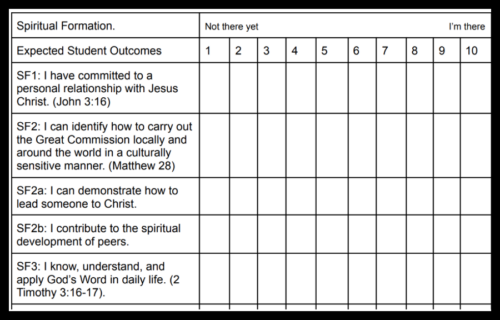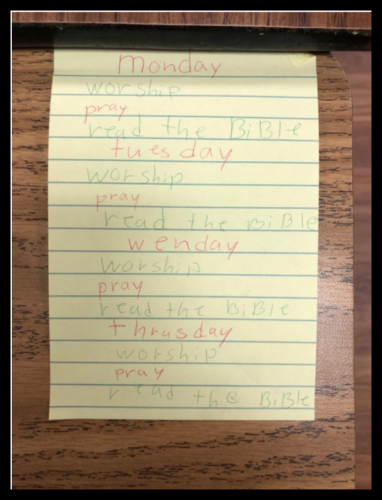I noticed Joe crying at the end of the line as his class entered the building after recess. I gave his teacher a questioning look, and she whispered a brief version of the story in my ear. I asked Joe if he wanted to discuss the problem, but he wasn’t ready. My heart broke for Joe. He had been struggling with various behavior issues throughout the school year, but what upset him now seemed to be a different matter. His parents, his teacher, and I had been collaborating to support Joe toward more godly choices. He was making good progress, and I prayed that the Lord would continue to transform Joe’s heart and mind. Reassuring Joe that I would be available if and when he wanted to talk, I patted him on the back and watched him follow his class upstairs.
About an hour later, Joe walked into my office. He was ready to talk. As he explained the whole story, I realized that I was witnessing an extraordinary moment. Although it was a typical playground story about a misunderstanding with a ball, Joe’s reaction to the situation was anything but typical for him. His explanation of what happened provided a real example of how Jesus is transforming him from the inside out. His story was one of integrity—he had wanted to keep his promise to return a borrowed ball to the PE teacher. However, some other students thought the ball was theirs and they took the ball back to their classroom. Joe’s tears spilled out of his frustration that he was unable to keep his promise. He was demonstrating integrity in wanting to keep his word.
This made me consider the faithfulness of Joe’s parents and his teacher. They have been faithful in the little things: diligently correcting Joe when he made poor choices, faithfully teaching him God’s Truth, and loving him unconditionally. The consistent teaching provided by parents and teachers is reaping dividends of integrity and self-control in Joe’s life. As I contemplated the situation, I knew Joe was growing in his walk with Christ, but I did not see a way to measure it. Maturity was happening before my eyes, but how do situations like this provide quantifiable evidence that my school is meeting its mission?
I shared this story with other teachers and celebrated the growth with Joe and his parents. In the thick of the school year, we don’t always get to see the fruit of our efforts. However, this leap in spiritual maturity was a testimony to the results of consistent teaching at home, church, and school. It also reminded me of Witwer’s goal of teaching Christianly: “Allowing our faith to influence what we teach and how we teach in order to encourage students towards greater love for God and neighbor” (Arnold & Witwer, 2023). Joe’s teacher certainly wanted him to meet academic outcomes, but she had another goal for him: that he would learn to behave in ways that demonstrated greater love for God and others.
Similar stories occur throughout the year when we see a glimpse of how the Lord is developing our students’ spiritual muscles, but can spiritual growth be quantified? One fourth-grade teaching team is developing different ways to assess this hard-to-quantify construct. Using our school’s expected student outcomes (ESOs), one teacher developed a survey for her students to reflect on their spiritual growth. Students completed the survey at the beginning of the year and will reassess halfway through and at the end of the year.

The teachers’ intentional focus on spiritual development in students has yielded other results. One student clearly articulated the Gospel in a project required for Bible class. Projects that demonstrate students’ understanding of Scriptural Truth can be a way to assess growth. The project below demonstrates one student’s understanding of some of the fundamentals of our faith. Not only do these projects make stunning displays, but student insights and knowledge are demonstrated in ways that might otherwise remain unseen.

One other example is the post-it note below that a teacher found on a student’s desk after a Bible lesson. The student created a plan to practice spiritual disciplines, unprompted by the teacher. Such self-reflection is a healthy habit that students can learn as a way to assess their own spiritual growth.

Assessing the spiritual growth of our students gives us a gauge of how effectively we are meeting our mission. Ridder (2023) emphasized the importance of assessing spiritual formation and spiritual programs in schools but noted many schools lack tools to measure these constructs effectively. Would simple student surveys, various projects, and spontaneous notes provide enough evidence my school intentionally and effectively develops students’ faith? Whether in anecdotal evidence or with quantifiable measures, we need ways to measure students’ growth in Christ.
In what ways do you assess the spiritual formation in your school?
Note: Joe is a pseudonym used to protect the identity of the student.
References
Arnold, M. & Witwer, M. (Hosts). (2023, November 8). Teaching Christianly by Mark Witwer Part 1 [Audio podcast episode]. In The Teacher’s Lounge Presented by Curriculum Trak. Apple Podcasts https://podcasts.apple.com/us/podcast/teaching-christianly-by-mark-witwer-part-1/id1617090804?i=1000634136935
Ridder, D. (2023, March 6). The assessment of spiritual formation. CurriculumTrak. https://www.curriculumtrak.com/blog/the-assessment-of-spiritual-formation
Photo by Priscilla Du Preez 🇨🇦 on Unsplash




